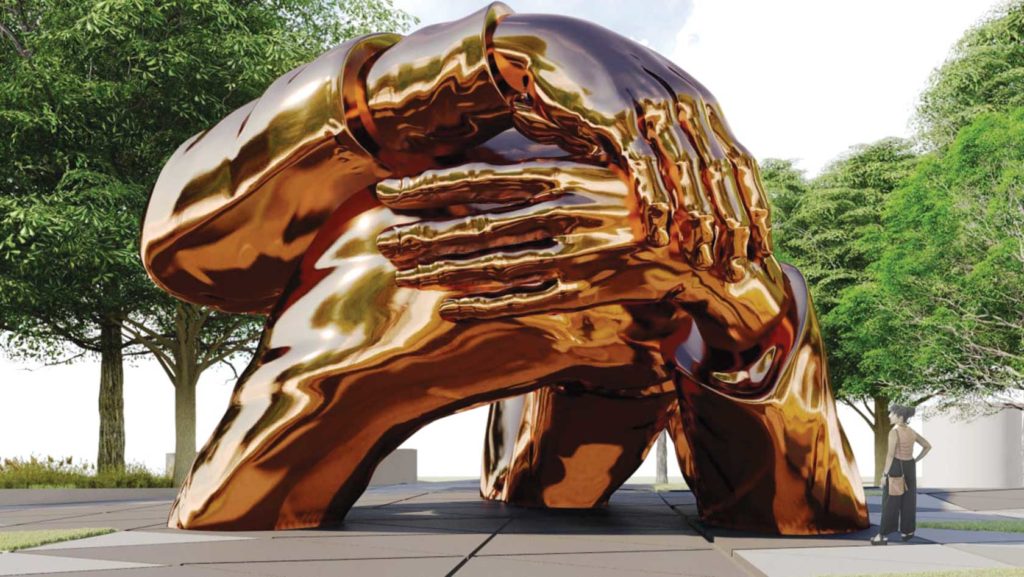Long road to recognition in a city King once called home
Bronze sculpture ‘The Embrace’ to be unveiled on Boston Common

Boston shares a distinction with Montgomery, Alabama; Chester, Pennsylvania; and Atlanta, Georgia. They are the only places the Rev. Dr. Martin Luther King lived for any length of time during his 39 years on earth.
Yet, unlike these other cities that King once called home — and many other major U.S. cities — Boston has until now had no major monument to the slain civil rights leader. When “The Embrace,” the bronze statue installed on the Boston Common is unveiled Friday, the city will finally have a major marker celebrating King and his late wife, Coretta Scott King, who met and courted in Boston, spending their first year of marriage in Roxbury.
“The major thing we’ve had is a street that goes nowhere,” former state Rep. Byron Rushing said, referring to Martin Luther King Boulevard in Roxbury, a wide thoroughfare that was originally designed to feed into a planned and scuttled highway extension through Roxbury. “That’s all we’ve had until now.”
Clennon King, a documentary filmmaker who has chronicled the Kings’ years in Boston, said, “It’s kind of tragic that Boston has been late to the game, but better late than never.”
King attended the Boston University School of Theology from 1952 to 1955. During that time, he lived at several addresses in the South End/Lower Roxbury area.
King also returned to the Boston area several times as a civil rights leader, most famously in 1965, when he led a march from Roxbury to the State House. There, he addressed the Legislature in a speech that touched on civil rights themes as they applied to Boston and Massachusetts.
In recent years, activists have worked to memorialize King’s stay here, including his courtship of Coretta Scott King.
The first official recognition of King in Boston was the renaming of the Campbell School in Dorchester to the Martin Luther King Jr. School in 1968, in the immediate aftermath of King’s assassination. In 1965, King had visited the then-predominantly Black school after his march downtown.
Naming the boulevard in Roxbury for King was somewhat low-hanging fruit for city officials. Laid out in a neighborhood that was cleared through urban renewal, the thoroughfare had no prior name.
“It doesn’t cost the city anything to name a street after someone,” Rushing noted.
The first sculpture dedicated to King was installed by Boston University in 1975 in front of the school’s library building. An abstract piece entitled “Free at Last,” the sculpture, created by Chilean sculptor Sergio Castillo, depicts 50 stylized doves soaring upward, representing peace in all 50 U.S. states.
Beyond the school, the boulevard and the BU statue, efforts to memorialize King in Boston were mostly limited to the annual King Breakfast, an event sponsored by St. Cyprian’s Church and Union United Methodist Church since 1970 that has become an important stop for civic leaders and community members on Martin Luther King’s birthday, which has been marked by a federal holiday since 1986.
In recent years, however, activists and artists have worked to tell more of King’s story in Boston. One such effort, the mural “Roxbury Love Story” at the corner of Shawmut Avenue and Melnea Cass Boulevard, depicts the Kings speaking to each other by telephone, referencing their first introduction.
The recently constructed apartment building on which the mural appears lies on the site of the 12th Baptist Church’s former building, where King sometimes preached.
Other memorials include plaques marking the buildings where King rented rooms, or apartments where he stayed. While there has long been a plaque marking the 397 Massachusetts Ave. building King once inhabited, it took a bit of doing for Clennon King to gain similar recognition for the Northampton Street address where the Kings first lived together after they were wed in Heiberger, Alabama, where Coretta’s family lived.
For one, the Northampton Street apartment building was razed during the construction of the Southwest Corridor, a depressed right-of-way that now accommodates the Orange Line, commuter rail and Amtrak trains, as well as a park. A plaque near the Carter School building marks the former address of the six-story apartment building where King began writing his thesis, before the couple moved to Montgomery.
Clennon King notes there are more locations that should bear markers. He points to the League of Women for Community Service building at 558 Massachusetts Ave., where Coretta lived for a year. The building, still in use by the organization that was founded by Black women, is currently undergoing a major renovation.
Another location would be Coretta’s first residence in Boston, 1 Chestnut Street on Beacon Hill, where she lived when she came to study at the New England Conservatory, cleaning house and doing laundry in exchange for her room. King said members of the condo association refused to entertain the idea of an historic marker for the address.
Another location the filmmaker cites is the corner of Gainsborough Street and Huntington Avenue. There, on the steps of Jordan Hall, Martin and Coretta met in person for the first time before heading to the Sharaf Café on Massachusetts Avenue.
There are other sites Clennon King rattles off: The 14 Wabon St. home then occupied by now-retired Judge Baron Martin, where King pledged the Alpha Phi Alpha fraternity; the spot in the Boston Public Garden where Martin and Coretta posed for a photograph; Carter Playground, where King and local civil rights activists began their march to the State House.
“There has been a deficit related to Boston telling the story of King and his wife,” Clennon King said.








